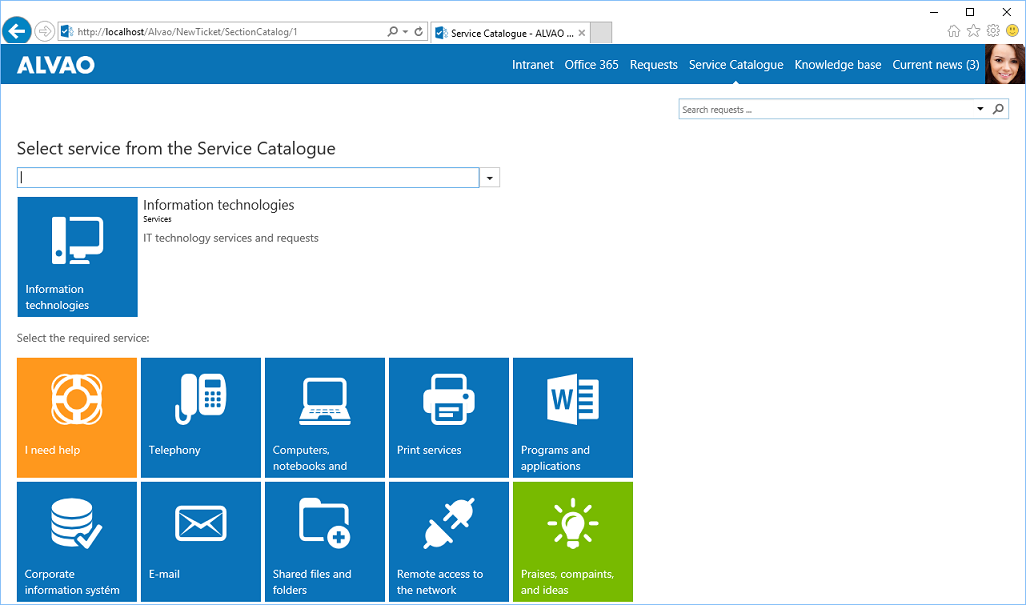Správa katalogu služeb
Katalog služeb je jednotné místo pro správu všech služeb poskytovaných servisními odděleními v celé organizaci (oddělení IT, oddělení HR, správa budov, správa vozového parku, ...). Cílem správy katalogu služeb je zajistit, aby katalog služeb odrážel skutečnou situaci v organizaci a aby služby byly dostupné těm uživatelům (žadatelům), kteří mají právo používat služby na dohodnutých úrovních (SLA).
Vývoj katalogu služeb by měl probíhat ve formě workshopu za účasti nejen členů servisních týmů (vnitřní pohled), ale zejména klíčových uživatelů služeb a obchodních zástupců (vnější pohled). Dobře navržený katalog služeb je intuitivní pro žadatele i výzkumníky, což snižuje potřebu přecházet mezi službami.
Správcem katalogu služeb je obvykle CIO společnosti (který je obvykle také správcem úrovně služeb).
Struktura
Katalog služeb by měl být strukturován logicky a služby mohou být seskupeny podle témat (např. podle odpovědností oddělení). Tím se vytvoří hierarchický katalog služeb nebo, chcete-li, strom služeb. Na základě zkušeností získaných při implementacích u našich zákazníků doporučujeme strukturovat katalog služeb následujícím způsobem:
-
věcné seskupení - např. aplikace - kancelářské aplikace - MS Office, počítače a koncové body - notebooky a tablety.
-
na poslední úrovni definovaného pracovního procesu ITIL (typicky Správa incidentů, Plnění požadavků, Správa změn, Správa problémů) - např. Incident, Požadavek, Změna, Problém.
Jak vypadá Service Desk ALVAO
Ukázka struktury služeb
- Změny podnikových norem
- Správa
- Informační technologie
- Potřebuji pomoc
- Telefonování
- Počítače, notebooky a tablety
- Tiskové služby
- Obtíže s používáním
- Tiskový požadavek
- Programy a aplikace
- Podnikový informační systém
- Nápověda k používání
- Nahlášení chyby nebo poruchy
- Řešení problémů
- Nastavení a změna přístupu
- Návrhy na zlepšení
- Sdílené soubory a složky
- Vzdálený přístup k síti
- Podpůrné služby
- Správa přístupu
- Aplikace
- Aplikace pro stolní počítače
- Systém ERP
- Výměna
- Incidenty
- Problémy
- Řízení změn
- Infrastruktura
- IT projekty
- Správa problémů
- Správa softwarových aktiv
- Pochvaly, stížnosti a nápady
- Správa budov
- Správa vozového parku
- Nákup na objednávku
- Údržba strojů
- Vývoj
- Personální oddělení
- Právní služby
- Finance
- Marketing
- Zabezpečení
- Kvalita
- Management
Uživatelská webová aplikace

S dobře navrženým katalogem služeb dochází jen k malé fluktuaci požadavků, protože intuitivní katalog, podpořený vhodnými ikonami a popisy, správně navede žadatele na poslední úroveň s konkrétním pracovním postupem. Pokud si žadatel z nějakého důvodu není jistý, kam má požadavek umístit, může jej vytvořit na jakékoli úrovni - řešitelé jej v rámci komunikace a diagnostiky žadatele přesunou do správné služby.
Služby, které mají možnost "Zobrazit v katalogu služeb" deaktivovanou v nastavení služeb, nejsou zobrazeny v katalogu služeb.
Příklad interní směrnice
Interní směrnice k této problematice by měla obsahovat následující informace:
Katalog služeb IT
- Seznam služeb poskytovaných interními pracovníky IT společnosti.
- Každý seznam by měl být samostatným dokumentem (uloženým např. na SharePointu) 3. Na tyto katalogové listy pak můžete odkazovat z formulářů Service Desk (pole popis).
| ID služby | S001 |
| Název služby | Počítače a příslušenství |
| Popis služby | Dodávky a servis počítačů a příslušenství
Připojení k interní podnikové síti Připojení počítače k interní podnikové síti Počítače jsou připojeny k interní síti: a) kabelem b) bezdrátově (wifi) Webový přístup Zajištění přístupu na web z vnitřní podnikové zdi Počítače jsou připojeny k internetu prostřednictvím vnitřní podnikové sítě. Připojení se nastaví automaticky. Není třeba jej nastavovat ručně. Přístup z interní sítě k webovým serverům na internetu není omezen. |
| Varianty | Obchod - notebook Design - stolní stanice Administrativa - stolní PC |
| Klíčový uživatel | Peter Smith (obchod) James Cooper (stavebnictví) Ann Young (administrativa) |
| Výchozí úrovně služeb | Dodání: RF001 - Standardní vyřešení požadavku Oprava: IM001 - Standardní řešení problémů |
| ID služby | S002 | |||||||||||||||||||||||||||||||||||
| Název služby | Standardní SW | |||||||||||||||||||||||||||||||||||
| Popis služby | Instalace a podpora standardního softwaru dodávaného s počítačem. | |||||||||||||||||||||||||||||||||||
| Možnosti |
| |||||||||||||||||||||||||||||||||||
| Key User | Peter Smith (obchod) James Cooper (stavebnictví) Ann Young (administrativa) | |||||||||||||||||||||||||||||||||||
| Výchozí úrovně služeb | Dodání: RF001 - Standardní vyřešení požadavku Oprava: IM001 - Standardní řešení problémů |
| ID služby | S003 |
| Název služby | Elektronická pošta |
| Popis služby | Správa elektronických poštovních schránek. Každý zaměstnanec má vlastní elektronickou schránku. Standardní formát adresy je <name.prijmeni>@contoso.com. Velikost poštovní schránky je omezena na 500 MB, viz doporučené nastavení pro automatickou archivaci. Obsah poštovní schránky je pro případ poruchy disku duplikován na dvou pevných discích. V případě zničení nebo krádeže serveru jsou data zálohována 2x ročně. |
| Možnosti | Žádné varianty této služby nejsou nabízeny. V případě jakýchkoli nestandardních potřeb zadejte požadavek v části Standardní řešení požadavků a oddělení se jím bude zabývat. |
| Klíčový uživatel | Peter Smith |
| Výchozí úrovně služeb | Dodávka: RF001 - Standardní vyřešení požadavku Oprava: IM001 - Standardní řešení problémů |
| ID služby | S004 | ||||||||
| Název služby | Sdílené soubory a složky | ||||||||
| Popis služby | Správa sdílených disků, jejich zálohování a archivace. Řešení problémů se sdílenými jednotkami a daty na nich, přidělování a změna přístupových práv. Sdílené disky jsou:
| ||||||||
| Varianty | Přístup je řízen podle pracovního zařazení (management, finanční oddělení, administrativní pracovníci, ...) | ||||||||
| Klíčový uživatel | Peter Smith | ||||||||
| Výchozí úrovně služeb | Dodání: RF001 - Standardní vyřešení požadavku Oprava: IM001 - Standardní řešení problémů |